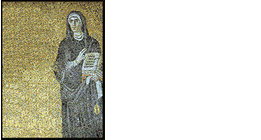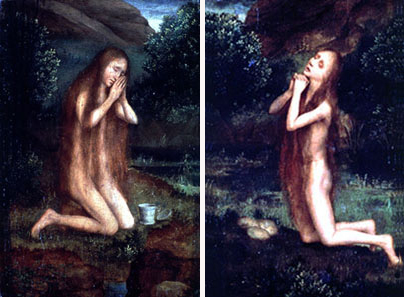 |
|
|
|
| Class Prep |
|
|
|
Holy
Harlots
 We return today to early Christian women of a different stripe than Jesus'
mother Mary and the martyrs Perpetua, Felicitas and Agnes. Today's women share
an opposite attribute in common, namely a promiscuous lifestyle that is converted
to one of chaste solitude. There are several accounts of holy harlots, from
Mary of Egypt to the actress Pelagia the harlot. The popularity of these
penitent prostitute tales may help to account for the transformation of Mary Magdalene
into a prostitute as well, a fact illustrated in the iconographic tradition. In
the picture to the right, the typical image of Mary of Egypt on the right (naked, anorexic,
repentant, with her 3 loaves of bread) is overtaken to depict Mary Magdalene on the left (we know it's the Magdalene because
of the open pot of ointment near her knee, which she brought to anoint Jesus'
body on the third day). We return today to early Christian women of a different stripe than Jesus'
mother Mary and the martyrs Perpetua, Felicitas and Agnes. Today's women share
an opposite attribute in common, namely a promiscuous lifestyle that is converted
to one of chaste solitude. There are several accounts of holy harlots, from
Mary of Egypt to the actress Pelagia the harlot. The popularity of these
penitent prostitute tales may help to account for the transformation of Mary Magdalene
into a prostitute as well, a fact illustrated in the iconographic tradition. In
the picture to the right, the typical image of Mary of Egypt on the right (naked, anorexic,
repentant, with her 3 loaves of bread) is overtaken to depict Mary Magdalene on the left (we know it's the Magdalene because
of the open pot of ointment near her knee, which she brought to anoint Jesus'
body on the third day). -
- As you read the accounts of the holy harlots
today, consider the following questions:
-
- How and
why do these women begin their lives of prostitution? How and why do they convert
from it? Or do they? Is their celibate life marked by any attributes that their
earlier lives of prostitution shared?
- Are these women still the object
of male desire? What do they do to prevent or encourage that?
- Mary
of Egypt inhabits the wilderness, much like Antony and Paul. Compare and contrast
her to them in terms of her physical depiction, her virtues and her temptations.
- Why would male authors encourage chastity by writing (or even creating?)
stories of converted prostitutes?
-
- Student excavators today, if we have any, will discuss the evidence of prostitution in the Roman Empire. It will help us to have some background on the circumstances of actual prostitutes before we can appreciate how early Christians used it to dramatize the experience of conversion. Stories
of holy harlots gained popularity in Christian antiquity as more and more "sinners" came into the faith after Constantine's legalization of Christianity. But the stories also took hold on the fringes of the Roman Empire, in
the Syrian east (from Antioch on the Orontes eastward to the Iraqi/Turkish city
of Nisibis), and we may have a presentation on those sites as well.
-
- We will also begin to read from Teresa Shaw's The Burden of the Flesh, about fasting and virginity "diets" in antiquity, in conjunction with a short essay by Michelle Lelwica on the spiritual dimension of contemporary eating disorders. From these brief readings, be able to answer the following question:
-
- What were the fasting practices of the desert ascetics, like
Mary of Egypt?
-
-
- Assigned Readings
-
- Primary: Excerpts from Sophronius' Life of Mary
of Egypt, Deacon James' Life of Pelagia the Harlot, and Ambrose, Concerning
Virgins 2.3-4 (all on Camino)
-
- Secondary: Burden of the Flesh 1-26; read pp. 15-27 from Lelwica, Starving for Salvation (Camino; you'll read the rest of hte chapter for next Tuesday); online class prep
-
- Optional: Garber, "Religious Habits"
(read only pp. 213-17), in Vested Interests: Cross-Dressing and Cultural Anxiety
(Camino)
-
- Slides for Lecture
-
-
- Dig Sites
-
-
-
- Further Reading
-
- Antoci, Peter M. "Scandal and Marginality
in the Vitae of Holy Fools." Christianity and Literature
44 (1995) 275-88.
-
- Burrus, Virginia. "Secrets of Seduction: The Lives of Holy
Harlots." In The Sex Lives of Saints: An Erotics of Ancient
Hagiography (Divinations: Rereading Late Ancient Religion; Philadelphia: University
of Pennsylvania Press, 2004) 128-59.
-
- Davis, Stephen J. "Crossed Texts, Crossed Sex: Intertextuality
and Gender in Early Christian Legends of Holy Women Disguised as Men." Journal
of Early Christian Studies 10 (2002) 1-36.
-
- Harvey, Susan Ashbrook. "Women
in Early Syrian Christianity." In Images of Women in Antiquity,
rev. ed. (ed. Averil Cameron and Amelie Kuhrt; Detroit: Wayne State University
Press, 1993; original 1983) 288-98.
-
- --------. "Is
there a Harlot in This Text? Asceticism and the Grotesque." Journal
of Medieval and Early Modern Studies 33 (2003) 419-35.
-
- Miller, Patricia Cox. "Desert Asceticism and 'The Body from Nowhere.'" Journal
of Early Christian Studies 2 (1994) 137-53.
-
- Pavloskis, Zoja. "The
Life of St. Pelagia the Harlot: Hagiographic Adaptation of Pagan Romance." Classical
Folia 30 (1976).
-
- Stevenson, Jane. "The Holy Sinner:
The Life of Mary of Egypt." In The Legend of Mary of Egypt
in Medieval Insular Hagiography (ed. Erich Poppe and Bianca Ross; Dublin:
Four Courts, 1996) 19-50.
-
- Syrkin, A. "On the Behavior
of the 'Fool for Christ's Sake.'" History of Religions
22 (1982) 150-71.
-
-
- Sources
-
- Photograph: Mary Magdalene,
Quentin Massys, John G. Johnson Collection, Philadelphia; reproduced in Marjorie
M. Malvern, Venus in Sackcloth: The Magdalen's Origins and Metamorphoses
(Carbondale, Illinois: Southern Illinois University Press, 1975) pl. 5, p. 78.
|
|
|
|
|
|
|
